Here are 9 Chair Exercises That Will Light Up Your Entire Body

Looking for a simple and convenient way to fit in a quick workout? Grab a seat: Chair exercises allow you to target pretty much your entire body—without having to invest in any additional equipment.
Chair exercises allow you to target your lower body while seated or supported, making them an excellent choice for anyone with balance or mobility issues or those who are recovering from an injury. They’re also great for pregnant people needing a little extra support as their belly grows. But it’s not just about your legs: You can also work upper-body muscles like your arms, shoulders, and chest while recruiting the critical core muscles to help with stabilization. Plus, a chair makes a perfect companion for doing seated stretches or Pilates chair exercises. So whether you’re sitting on a chair or simply holding onto one for support, you can definitely get a lot out of these exercises.

And perhaps the best part may be how convenient they make working out. Chair exercises are all doable at home, the gym, and some even while sitting in a Zoom meeting (trust us, we’ve done it!).
“Anyone can benefit from using a chair, but many times a chair is good for people who have a hard time getting up and down from the floor or just need support,” NSCA-certified personal trainer, Morit Summers, CPT, and founder of Morit Summers Personal Training, tells SELF. “In fitness, we need to learn to trust our bodies, and having a safety net like a chair can really help build that confidence.”
This is especially true for a beginner who may need that safety net while creating trust in their body with movement. Plus, chair exercises help you focus on the movements themselves without worrying about balance, Summers explains. This can be helpful for both beginners and for more advanced exercisers looking to master progressions.

There are tons of exercises you can do with a chair—some are variations of tried-and-true moves you’ve likely done before, while others are more chair-specific—but we’ve rounded up nine of our favorites below. Before we get into our favorite picks, though, we’ll cover the ins and outs of chair exercises, including their effectiveness and why using a chair is beneficial for just about anyone who needs a solid, total-body routine.
How effective are chair exercises?
When done correctly, Summers says chair exercises can be incredibly effective, allowing you to work all the muscles in your body. The key to an effective chair workout is simple: Incorporate exercises that recruit as many muscle groups as possible while still allowing you to remain seated (if needed) or using the chair for balance or as part of the exercise.
One reason they’re so effective is because many of them work the same way as moves you’re already familiar with. Take a plank or push-up, for instance, where your hands are elevated on the seat. While the chair puts your body at an incline—which helps take some of the weight away—you’re still performing the same basic exercise, says Summers.

“Just because you’re using a chair, it does not change the purpose or movement; it changes the angle at which the exercise is performed and the way you’ll get it done,” she says. That means a push-up from a chair will still effectively work your chest muscles, shoulders, and triceps, while a plank from a chair will still fire up your entire core. So if you’re looking for a strengthen the core workout, chair exercises can help deliver.
Are chair exercises just for beginners?
Nope. The beauty of chair exercises is that they are scalable to different fitness levels. A chair allows you to both progress and regress moves, making them great for building on your fitness level.
A chair can take a basic move like a squat and make it easier to perform—while also requiring stricter form and giving you a cue (the seat!) as to how far to lower your body. Summers says when learning proper squat technique, a chair gives you a physical cue that allows you to go lower without feeling like you’re falling. It’s also there to sit on if needed. That said, she makes it clear that there is a huge difference between plopping down on the chair versus sitting with control (FYI: You’ll want to sit with control).
Chairs are also great tools for introducing more challenging exercises into the mix. Let’s go back to push-ups, for example. A traditional push-up, where you complete the move from the floor, is a difficult move. But elevating your hands can help make it more doable. So your first step might be performing a push-up with your hands elevated on the seat of a chair. Then once you’ve mastered that you may be able to take the surface closer to the ground—like on a box or step—before performing them right from the floor. Then, to kick it up even further, you can put your feet on the seat of the chair and your hands on the ground, for a decline push-up that feels way harder than a traditional version.
Same applies to a pistol squat, where you squat all the way down with one leg out in front of you. This is a really advanced move. But a chair exercise like a staggered squat (where you raise one leg off the ground in front of you and squat down with the planted foot until your butt touches the chair’s seat) can help you get used to that movement pattern and build the single-leg strength you’d need to complete it.
What exercises can I do while sitting in a chair?
You can do tons of variations of familiar strength-training moves, as well as some chair-specific exercises! If standing exercises are not possible, or you’re just looking to mix things up, performing modified moves with a chair can pretty much work every muscle in some way.
Chair exercises can also include cardio moves that boost your heart rate, like seated marching or jacks. Finally, seated stretches, chair exercises for abs, and chair yoga exercises are just a few additional categories to consider when designing a routine.

Plus, it’s not only about what exercises you can do when seated in a chair: If weight-bearing is possible, you can also try standing exercises that use a chair as a prop. Pilates chair exercises—think Pilates barre—are a great example of incorporating a chair into a routine. Instead of a ballet bar, simply grab the back of a chair for support. Just make sure it is sturdy, secure, and tall enough to support your weight. For example, you can try some Pilates chair exercises like leg raises or circles, ballerina squats, plié pulses, and different foot positions (first, second, and third).
How can I work out my legs seated or with a chair?
When working your legs with a chair, it’s important to really hone in on your mind-muscle connection. Make sure to fire your leg, hip, or glute muscles while you’re working them.
For example, when doing a box squat, really focus on feeling your quads and glutes as you lower your body toward the chair and keep the muscles engaged as you push through your heels to stand up. Or, when doing the glute kick back, remember to really squeeze your glutes as you extend your leg. Also, try to avoid leaning too much on the chair when performing these moves. As you become more familiar with these exercises, you’ll be able to determine how much you need to rely on the chair for balance and stability.
You can also work your legs when seated by doing stretches, like a seated hamstring stretch, or by performing rehab-type exercises like the foot alphabet. And if you’re doing exercises while actually sitting on the chair, make sure you keep your core engaged and posture upright.
What do you need to know before you start chair exercise?
Make sure the chair you choose is sturdy and able to hold your body weight. That means you may need a different chair for these exercises from your regular work chair—many of the best ergonomic chairs are wheeled, which are no-gos for working out. And be sure to check the floor for slippage; you don’t want the chair to move around while working out. If there’s any movement, slide a yoga mat under the chair.
Also, if you’re looking to add chair exercises due to an injury (whether it’s back discomfort, pain in the neck, or pain in your hips, knees, or ankles), mobility or balance issues, it’s a good idea to get any new exercise program cleared by a doctor or physical therapist first.

Chair Exercises
- Mountain Climber
- Triceps Dip
- Elevated Push-Up
- Box Squat
- Lateral Leg Circles
- Seated Jack
- Bulgarian Split Squat
- Glute Kick Back
- Alternating Cross Crunch
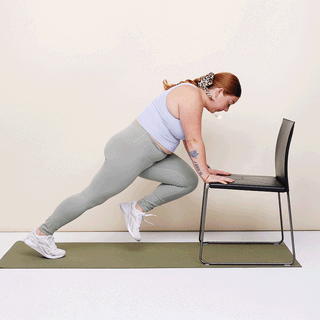
- Mountain Climber
- Stand facing a sturdy chair with your feet hip-width apart and arms at your sides.
- Lower your upper body toward the chair and place your palms flat on the edge of the seat directly below your shoulders.
- Extend your legs straight out behind you with your toes planted and heels elevated off the floor.
- Brace your core muscles and keep your back flat and straight. Keep your eyes looking down at the seat. Your body will be at a slight angle.
- Bring your right knee toward your right arm. Then, as the right leg returns to the starting position, bring your knee toward your left arm. That’s 1 rep.
- Continue alternating. Keep the pace moderate and modify if needed. To make it easier, perform this movement at a walking speed. Quicken the pace to make it more advanced.
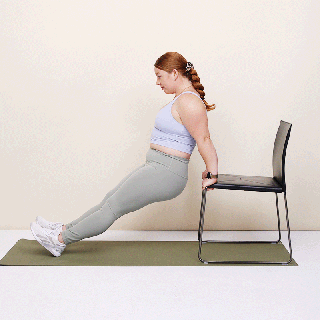
- Triceps Dip
- Stand with your feet hip-width apart and back facing a sturdy chair. Sit down on the edge of the seat.
- Place the palms of your hands on the edge of the seat, shoulder-width apart. Your fingers will wrap around the edge of the seat.
- Slide your butt off the seat and extend your legs in front of you with your heels on the floor and toes pointing up.
- Slowly bend your elbows and lower down as low as you can go. If you feel discomfort in your shoulder or wrists, decrease the distance you lower your body.
- Pause at the bottom and contract your triceps (muscles in the back of your upper arm) to push yourself back up to starting position. This is 1 rep.ADVERTISEMENThttps://f2b91c1638d4c9f32739a1dc28fabeaf.safeframe.googlesyndication.com/safeframe/1-0-38/html/container.html
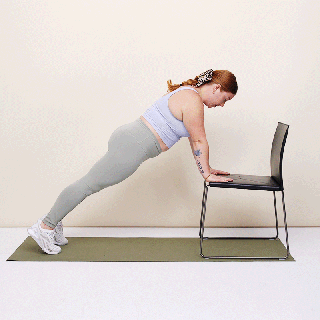
- Elevated Push-Up
- Stand facing a sturdy chair with your feet hip-width apart and arms at your sides.
- Lower your upper body toward the chair and place your palms flat on the seat. They should be directly below your shoulders.
- Extend your legs straight out behind you with your toes planted and heels elevated off the floor.
- Brace your core muscles and keep your back flat and straight. Keep your eyes looking down at the seat. Your body will be at a slight angle.
- Bend your elbows to slowly lower your chest to the seat until the elbows are at a 90-degree angle.
- Push your body away from the chair until your elbows are extended. This is 1 rep.
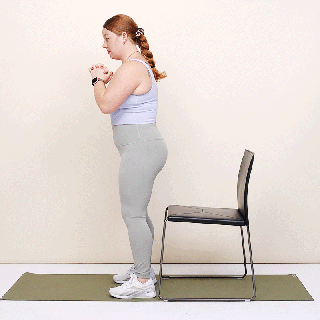
- Squat
- Stand with your feet shoulder-width apart and back facing a sturdy chair. Clasp your hands together to make a fist and hold in front of your chest. Your heels should be close to the chair legs.
- Brace your core, shift your weight into your heels, push your hips back, and bend your knees to lower into a squat. Lower your butt to the chair without sitting on it.
- Pause at the bottom of the squat, and drive through your heels to stand, squeezing your glutes at the top. This is 1 rep.
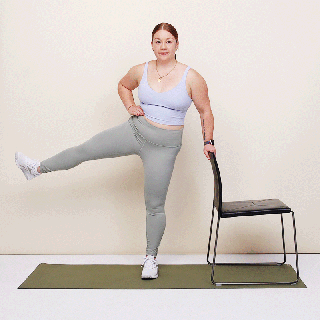
- Lateral Leg Circles
- Stand behind a sturdy chair with your left leg closest to the back of the chair. You should be about a foot away from the chair.
- Rest your left hand on the top of the chair and keep your right hand on your waist.
- Raise your right leg out to the side as high as possible and hold. You should feel the hip muscles contracting.
- Begin circling your leg clockwise, moving from the hip.
- For an added challenge, you can then repeat the circles in a counter-clockwise motion.
- When you’re finished, switch sides and repeat.
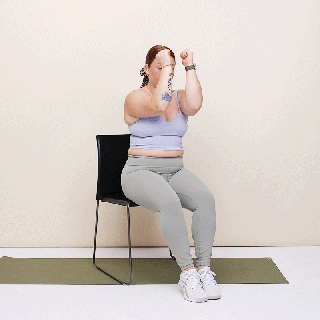
- Seated Jack
- Sit on the seat of a sturdy chair with your torso upright, away from the back of the chair.
- Place your feet together and raise your arms up to make a goalpost. Your upper arms will be parallel to the floor and lower arms perpendicular to the floor. Start with your arms in the closed position with your elbows close together.
- Step your feet out to the sides in a jumping jack motion while opening your arms to the sides. You will now be in the goalpost position.
- Squeeze your shoulder blades together while also squeezing your glute muscles to return to starting position. This is 1 rep. The quicker you perform this move, the greater the cardiovascular challenge will be.
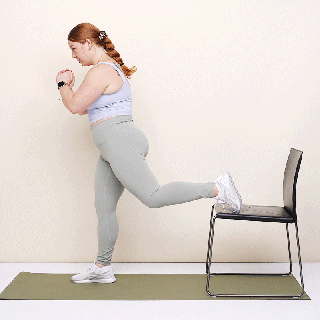
- Bulgarian Split Squat
- Stand with your back toward a sturdy chair. With your right foot on the floor a few feet in front of the chair, place the top of your left foot on the seat of the chair, toes down.
- Clasp your hands together to make a fist and hold in front of your chest. (If you’re more comfortable, you can place your hands behind your head instead.) Keep your chest up and look straight ahead.
- Engage your core as you bend your knees to lower down into a split squat. Your right knee should ideally form a 90-degree angle so that your thigh is parallel to the ground, and your left knee is hovering above the floor. (Quick position check: Your right foot should be stepped out far enough that you can do this without letting your right knee go past your right toes.)
- Driving through your left heel, stand back up to starting position. This is 1 rep. Do all your reps on one side, then switch sides.
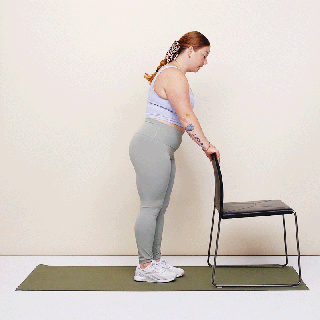
- Glute Kick Back
- Stand facing the back of a sturdy chair with feet about 8 to 12 inches away from it.
- Place your hands on the top of the back of the chair.
- Brace your core, engage the glute muscles, and extend your right leg behind you. Your toes will point down and heels toward the ceiling.
- Pause for a moment with your leg extended behind you. You should feel the contraction in your right glute.
- Lower your right leg to the starting position. Make sure to keep the movement slow and controlled. This is 1 rep.
- Complete all your reps on on side, then switch sides. To make this harder, you can wrap a mini-band above your knees or ankles.
- Sit on the seat of a sturdy chair with your torso upright away from the back of it.
- Place your feet about hip-width apart flat on the floor and your fingertips behind your head, elbows pointing out to the sides.
- Raise your left foot off the floor and bring your right elbow toward your left knee by twisting your torso. Touch your right elbow to the left knee if you can and squeeze your obliques while you are rotating and crunching.
- Repeat the same motion with the left elbow and right knee. This is 1 rep.
- Continue alternating.
